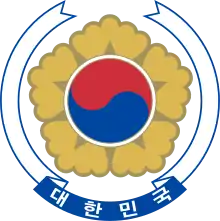1985 South Korean legislative election
Legislative elections were held in South Korea on 12 February 1985.[1] The result was a victory for the Democratic Justice Party, which won 148 of the 276 seats in the National Assembly. Voter turnout was 84.6%.
| |||||||||||||||||||||||||||||||||||||||||||||||||||||||||||||||||
All 276 seats to the National Assembly 139 seats needed for a majority | |||||||||||||||||||||||||||||||||||||||||||||||||||||||||||||||||
|---|---|---|---|---|---|---|---|---|---|---|---|---|---|---|---|---|---|---|---|---|---|---|---|---|---|---|---|---|---|---|---|---|---|---|---|---|---|---|---|---|---|---|---|---|---|---|---|---|---|---|---|---|---|---|---|---|---|---|---|---|---|---|---|---|---|
| Turnout | 84.6% ( | ||||||||||||||||||||||||||||||||||||||||||||||||||||||||||||||||
| |||||||||||||||||||||||||||||||||||||||||||||||||||||||||||||||||
 |
|---|
| This article is part of a series on the politics and government of the Republic of Korea |
|
|
Parties
The ruling Democratic Justice Party (DJP) of President Chun Doo-hwan managed to remain the largest party in the National Assembly but faced a tougher challenge from the united opposition.
The New Korea and Democratic Party (NKDP) was formed by former members of the New Democratic Party, notably opposition leaders Kim Dae-jung and Kim Young-sam despite they were still barred from running elections. The party made strong gains across the country, largely thanks to its focus on greater democratic rights.
The Korean National Party had been formed by former members of the Democratic Republican Party in the run-up to the 1981 elections. After making some key gains, the party lost ground in these elections, largely thanks to the gains of the NKDP.
The opposition Democratic Korea Party had been the premier opposition party following the 1981 elections, but it suffered major defections to the NKDP.
Results
| Party | Votes | % | Seats | ||||
|---|---|---|---|---|---|---|---|
| FPTP | PR | Total | +/– | ||||
| Democratic Justice Party | 7,040,811 | 35.2 | 87 | 61 | 148 | –3 | |
| New Korea and Democratic Party | 5,843,827 | 29.3 | 50 | 17 | 67 | New | |
| Democratic Korea Party | 3,930,966 | 19.7 | 26 | 9 | 35 | –46 | |
| Korean National Party | 1,828,744 | 9.2 | 15 | 5 | 20 | –5 | |
| New Socialist Party | 288,863 | 1.4 | 1 | 0 | 1 | New | |
| Workers and Farmers Party | 185,859 | 0.9 | 0 | 0 | 0 | New | |
| New Democratic Party | 112,654 | 0.6 | 1 | 0 | 1 | New | |
| Civil Rights Party | 75,634 | 0.4 | 0 | 0 | 0 | –2 | |
| National Group Party | 17,257 | 0.1 | 0 | 0 | 0 | New | |
| Independents | 650,028 | 3.3 | 4 | 0 | 4 | –7 | |
| Invalid/blank votes | 312,029 | – | – | – | – | – | |
| Total | 20,286,672 | 100 | 184 | 92 | 276 | 0 | |
| Registered voters/turnout | 23,987,830 | 84.6 | – | – | – | – | |
| Source: Nohlen et al. | |||||||
Results by city/province
| Region | Total seats |
Seats won | ||||||
|---|---|---|---|---|---|---|---|---|
| Democratic Justice | NKDP | Democratic Korea | Korean National | New Socialist | New Democratic | Ind. | ||
| Seoul | 28 | 13 | 14 | 1 | 0 | 0 | 0 | 0 |
| Busan | 12 | 3 | 6 | 2 | 1 | 0 | 0 | 0 |
| Daegu | 6 | 2 | 2 | 1 | 1 | 0 | 0 | 0 |
| Incheon | 4 | 2 | 2 | 0 | 0 | 0 | 0 | 0 |
| Gyeonggi | 20 | 10 | 4 | 3 | 3 | 0 | 0 | 0 |
| Gangwon | 12 | 6 | 0 | 1 | 4 | 0 | 0 | 1 |
| North Chungcheong | 8 | 4 | 2 | 1 | 1 | 0 | 0 | 0 |
| South Chungcheong | 16 | 8 | 4 | 4 | 0 | 0 | 0 | 0 |
| North Jeolla | 14 | 7 | 2 | 1 | 3 | 0 | 1 | 0 |
| South Jeolla | 22 | 11 | 5 | 5 | 0 | 1 | 0 | 0 |
| North Gyeongsang | 20 | 10 | 4 | 3 | 1 | 0 | 0 | 2 |
| South Gyeongsang | 20 | 10 | 5 | 4 | 1 | 0 | 0 | 0 |
| Jeju | 2 | 1 | 0 | 0 | 0 | 0 | 0 | 1 |
| Constituency total | 184 | 87 | 50 | 26 | 15 | 1 | 1 | 4 |
| PR list | 92 | 61 | 17 | 9 | 5 | 0 | 0 | 0 |
| Total | 276 | 148 | 67 | 35 | 20 | 1 | 1 | 4 |
References
- Dieter Nohlen, Florian Grotz & Christof Hartmann (2001) Elections in Asia: A data handbook, Volume II, p420 ISBN 0-19-924959-8